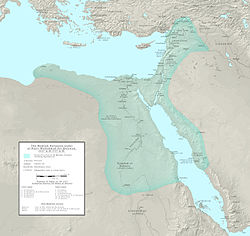Mamluk Sultanate
Mamluk Sultanate | |||||||||||||||||||||||
|---|---|---|---|---|---|---|---|---|---|---|---|---|---|---|---|---|---|---|---|---|---|---|---|
| 1250–1517 | |||||||||||||||||||||||
|
Flags according to the Catalan Atlas of c. 1375 | |||||||||||||||||||||||
| Attributed arms of the Mamluk Sultan (by Mecia de Viladestes map, 1413) | |||||||||||||||||||||||
 Extent of the Mamluk Sultanate under Sultan an-Nasir Muhammad | |||||||||||||||||||||||
| Capital | Cairo | ||||||||||||||||||||||
| Common languages | |||||||||||||||||||||||
| Religion |
| ||||||||||||||||||||||
| Government | Sultanate under ceremonial Caliphate[4] | ||||||||||||||||||||||
| Caliph | |||||||||||||||||||||||
• 1261 | Al-Mustansir (first) | ||||||||||||||||||||||
• 1262–1302 | Al-Hakim I | ||||||||||||||||||||||
• 1406–1414 | Abū al-Faḍl Al-Musta'in | ||||||||||||||||||||||
• 1508–1516 | Al-Mutawakkil III (last) | ||||||||||||||||||||||
| Sultan | |||||||||||||||||||||||
• 1250 | Shajar ad-Durr (first) | ||||||||||||||||||||||
• 1250–1257 | Izz al-Din Aybak | ||||||||||||||||||||||
• 1260–1277 | Baibars | ||||||||||||||||||||||
• 1516–1517 | Tuman bay II (last) | ||||||||||||||||||||||
| History | |||||||||||||||||||||||
• Murder of Turanshah | 2 May 1250 | ||||||||||||||||||||||
| 22 January 1517 | |||||||||||||||||||||||
| |||||||||||||||||||||||
The Mamluk Sultanate (Arabic: سلطنة المماليك, romanized: Salṭanat al-Mamālīk), also known as Mamluk Egypt or the Mamluk Empire, was a state that controlled Egypt, The Levant, and Hejaz from 1250 to 1517.[5][6][7] The first sultans (kings) of the Mamluk Sultanate were mamluks (slave-soldiers) in the armies of the Ayyubid dynasty. The Mamluk Sultanate was the strongest military power in the central Muslim world. They fended off the Mongols and exterminated the Crusaders in the Holy Land (The Levant).[8] The Mamluk sultans also controlled south-eastern Asia Minor and western Arabia.[8] Most of the sultanate's mamluks were Turkic people or Circassians.[7][5] The Arabic language was the state's and the government's most important language. Most of the sultans carried Arabic names and were heavily Arabized.[7]
References
[change | change source]- ↑ Rabbat 2001, p. 69.
- ↑ Fischel 1967, p. 72.
- ↑ Turan, Fikret; Boeschoten, Hendrik; Stein, Heidi (2007). "The Mamluks and Their Acceptance of Oghuz Turkish as Literary Language: Political Maneuver or Cultural Aspiration?". Turcologica. Harrassowitz.
- ↑ Stilt, Kristen (2011). Islamic Law in Action: Authority, Discretion, and Everyday Experiences in Mamluk Egypt. OUP Oxford. ISBN 978-0-19-960243-8.
- ↑ 5.0 5.1 Keough, Leyla (2010). "Mamluk State". In Gates, Henry Louis, Jr.; Appiah, Kwame Anthony (eds.). Encyclopedia of Africa (online ed.). Oxford University Press. doi:10.1093/acref/9780195337709.001.0001. ISBN 978-0-19-533770-9.
{{cite book}}: CS1 maint: multiple names: editors list (link) - ↑ Kazhdan, Alexander P.; Talbot, Alice-Mary (2005) [1991]. "Mamlūks". In Kazhdan, Alexander P. (ed.). The Oxford Dictionary of Byzantium (online ed.). Oxford University Press. doi:10.1093/acref/9780195046526.001.0001. ISBN 978-0-19-504652-6.
- ↑ 7.0 7.1 7.2 Bloom, Jonathan M.; Blair, Sheila S., eds. (2009). "Mamluk". The Grove Encyclopedia of Islamic Art and Architecture (online ed.). Oxford University Press. doi:10.1093/acref/9780195309911.001.0001. ISBN 978-0-19-530991-1.
- ↑ 8.0 8.1 Esposito, John L., ed. (2003). "Mamluks". The Oxford Dictionary of Islam (online ed.). Oxford University Press. doi:10.1093/acref/9780195125580.001.0001. ISBN 978-0-19-512558-0.



